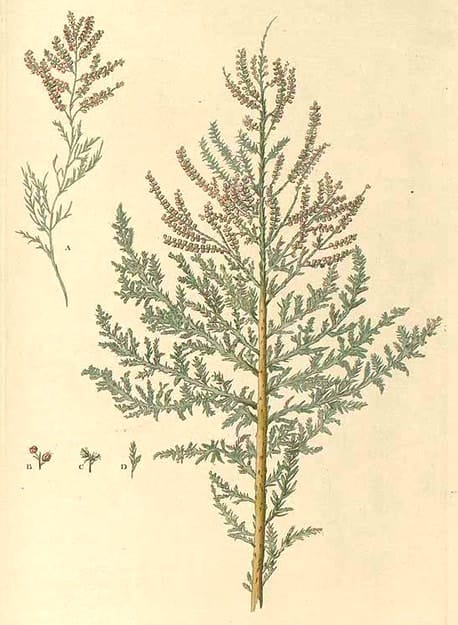Tamarix chinensis, Xi He Liu 西河柳
Chinese TamariskXi He Liu, Cheng Liu (TCM)
 Tamarix chinensis
Tamarix chinensisPallas, Flora rossica seu stirpium imperii rossici (1784-1815)
Botanical name:
Tamarix chinensis (syn. T. pentandra)
Also used are T. juniperina, T. ramosissima
See also the related Western Tamarisk, T. gallica.
Parts used:
Stem and Leaf
Temperature & Taste:
Neutral/Slightly Warm, dry. Pungent, Sweet
Classifications:
A. Clear the Exterior
Uses:
1. Clears Wind, Resists Poison, Promotes Rashes:
-incomplete expression of Measles and Chickenpox rash (specific)
-Itching skin and Rashes from Wind; Urticaria, Pruritus
-Common Cold; Influenza (Barefoot Doctors Manual)
-also for Chronic Bronchitis, Rheumatic Arthritis and Alcohol intoxication
Dose:
Decoction: 3–9 grams
Can be used topically as a wash.
Comment:
It is probable that the Western Tamarisk (T. gallica) and the Chinese Tamarisk (T. chinensis) may be synonymous in effect. However, due to their different uses in East and West, we have separated them into different entries.
Main Combinations:
1. Promote expression of Measles rash:
i. Tamarix chinensis with Mint (Bo He), Cimicifuga Sheng Ma, Cicada Slough (Chan Tui)
ii. with High Fever, no sweating, dry skin )Wind-Cold obstructing the exterior with internal Heat-Toxin), Tamarix chinensis with Cimicifuga Sheng Ma, Schizonepeta Jing Jie, Pueraria Ge Gen, Platycodon Jie Geng
2. Wind Rashes:
i. Tamarix chinensis with Burdock seed (Niu Bang Zi), Bamboo leaf (Zhu Ye)
Major Formulas:
Cautions:
1. Avoid overdose
2. Not used for Measles rash when there is full expression of the Rash.
3. Not used for profuse sweating from deficiency.
Toxicity:
Overdose may cause vomiting, dizziness, sweating, spasms, leading to low blood pressure and shock.
